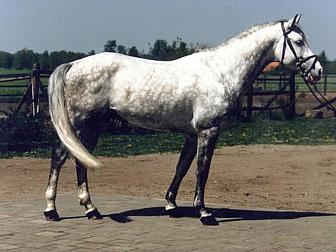
OVERVIEW
The Shagya Arabian was developed as a cavalry horse for the famous Hungarian light cavalry. The origins of the breed lie in the Babolna stud in Hungary around 1816. Although not in the strictest sense an Arabian because some of the early foundation sires were not of Arabian stock, the Shagya carries many of the typical characteristics of the Seglawi Arabian type. A riding horse of quality and substance, the Shagya can also be used successfully in harness and is even used in competition.
PHYSICAL DESCRIPTION
The Shagya Arabian is almost always gray, but does exist in all solid colors. The horse is generally taller than most Arabian breeds, standing around 15 hands high. The beautiful head is accentuated by large eyes and an extremely wide forehead. The shoulders and hindlegs are of more conventional riding-type than pure-bred Arabians. A compact back and loins are "virtually perfect," with forelegs being clear of the body providing for good action. Although the outline of the horse is that of a high-class Arabian, the body is large and more substantial.
ORIGIN
In 1816, an army order was issued stating that all Babolna mares should be covered with Oriental stallions leading the stud to import pure desert Arabians and, later on, Arabian "halfbreeds." 1836 brought the sire to the modern line of Shagya Arabians. From Syria, the stallion Shagya was of the Kehil/Siglavi strain, but stood higher than the average specimen at 15.2 1/2 hh. This horse was bred with Arabian mares containing strains of Spanish, Hungarian, and Thoroughbred blood. The descendants of Shagya are now at stud in the U.S., Poland, Germany, Austria, Romania, the former Yugoslavia, and the Czech Republic.
INTERESTING FACTS
The founding sire of the breed that took his name, Shagya, was brought into the Babolna stud in the 1830s. Of the 5 mares and 9 Arabian stallions that were brought to Hungary, Shagya proved to be the most successful. His stallion descendants, now at stud throughout the world, take on his name followed by the Roman numeral indicating the number of generational separation from the foundation sire.
INFLUENCES
1. Arabian
For more information:
North American Shagya-Arabian Society